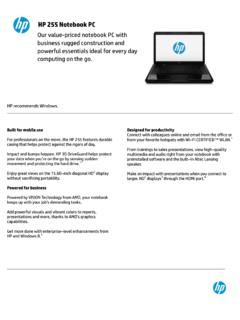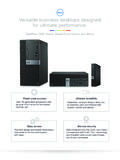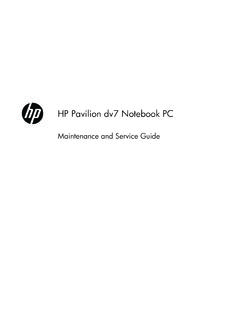Transcription of AMD Radeon RAMDisk
1 AMD Radeon RAMDisk User's Manual and FAQ 1 Revision Tracker Revision Number Software Version Description Revision Date 04 Initial Release October 2012 05 Version Update March 2013 06 Version Update June 2013 07 Version Update October 2013 08 Version Update December 2013 2 3 Table of Contents 1. Introduction to RAMDisk .. 5 What is RAMDisk ? .. 5 How does it work? .. 5 What is the benefit? .. 5 2. Screen-by-screen definition of settings .. 7 Menus and Start/Stop Buttons .. 7 Settings Tab .. 9 Advanced Settings Tab .. 15 Load/Save Tab .. 17 Event Log Tab .. 20 Options Tab .. 21 3. Technical Know How .. 23 Swap Space .. 23 Temp 23 System Restore .. 24 "Found New Hardware" Message .. 24 Disk 24 License Files .. 25 Installing .. 25 Uninstalling .. 25 Support.
2 26 4. Frequently Asked Questions .. 27 1. Can I run RAMDisk on 64-bit versions of Windows? .. 27 2. Can I format a RAMDisk drive? .. 27 3. How do I create a non NTFS formatted RAM disk? .. 28 4. Can I modify the partitions on the RAM disk? .. 28 5. Why doesn't the image file timestamp seem to be changing when I have AutoSave turned on? .. 28 6. Can I boot from RAMDisk ? .. 28 7. The driver is started but I don't see a drive letter for the RAM disk in My Computer.. 28 8. Can I use a RAMDisk as a raw drive for a virtual machine (VMWare or VirtualBox)? .. 28 9. On RAMDisk application launch user gets error : Unable to read hardware info: Unexpected error 6 at line 123 .. 29 10. Why are disk size and other options grayed out on first tab in and or .. 29 Why can I not change the disk size? .. 29 4 11. Error Code 2203 or 2205 on RAMDisk installation.
3 29 12. Where do I download the previous version from?.. 29 13. RAMDisk installer fails with message indicating absence of .NET Framework . But framework and above is already installed.. 29 14. Even after uninstall RAMDisk continues to show in diskmgmt and uses up RAM.. 29 15. User manual and release notes do not load.. 30 16. Cannot uninstall RAMDisk on windows .. 30 17. Troubleshooting .. 32 5. Known Issues .. 34 5 1. Introduction to RAMDisk What is RAMDisk ? RAMDisk is a program that takes a portion of your system memory and uses it as a disk drive. Conceptually, turning your memory into a usable disk drive may appear simple, but in practice there are many complex variables to deal with when operating a RAMDisk in Windows. This software is designed to be user-friendly no matter what your PC knowledge may be.
4 Improvements will continue to be made to ensure new builds remain as easy as possible for end users. Regular software updates will be provided to improve features and address customer requests. It is highly recommended that all users READ THE INSTRUCTIONS (this document) before trying the various RAMDisk settings. How does it work? RAMDisk is a kernel-level driver that presents a standard disk drive to the OS. However, it stores and retrieves data from the system RAM on your motherboard instead of an actual, physical disk. Along with the Kernel Driver is a GUI that talks to the driver and allows the user to set various options as well as start and stop the Driver (create or delete a RAMDisk ). The Driver has been written to WDM standards and creates a low-level disk object that Windows Device Manager and Disk Management are able to "see" and manage.
5 You can partition, format, mount a volume, and assign multiple drive letters to RAMDisk (but only if you would know how to do those things with a regular disk, RAMDisk does not do multiple drive letters for you). Upon successful start of the RAMDisk , a kernel level driver ( ) is loaded into the Windows/System32/drivers folder. This driver will be available to Windows each time RAMDisk starts. It is removed when RAMDisk is stopped. What is the benefit? In a word: SPEED! Most users use RAMDisk to speed up applications like: 6 Games Internet Explorer cache for faster web surfing Audio and Video editing CAD programs Software compilers Databases Speeding up CD duplication SETI processing TEMP files Swap space Web server cache Custom applications with high I/O, high bandwidth, or high security requirements Some users like the security of the RAMDisk because if you do not choose to back up the RAMDisk , all information will be wiped upon power loss or shutdown.
6 Since RAM cannot store any trace of information without power, you know the information is gone for good (not just hidden on a track of a hard drive that can be easily undeleted and even recovered after successive over-writes). An additional feature of a RAMDisk is that it will never wear out. You can access it at maximum bandwidth 24/7/365 without fear of mechanical failure or fragmentation (a RAMDisk can become fragmented just like any other disk, but it does not take a performance hit like a physical disk does when it becomes fragmented). A RAMDisk operating at maximum bandwidth does not produce excessive heat, noise or vibrations. 7 2. Screen-by-screen definition of settings Menus and Start/Stop Buttons The menu items, the Start RAMDisk , and the Stop RAMDisk buttons are available from all tabs in the GUI.
7 File: Under this menu item you can: Save Settings: Saves your configuration settings Restore Default Settings: Restores the default settings, in case you need to get back to a known good state Restore Last Saved [PAID Version only]: Restores the settings you had last saved. Restore Active Settings [PAID Version only]: Restores the settings from the current, running configuration Save Disk Image Now: Write a disk image immediately to a specified filename. 8 Exit: Exits the GUI, but does not affect the Driver. Only Start and Stop will actually create or delete the RAMDisk View: Under this menu item you can select: Advanced: Choose between a simplified settings view and an advanced view with more options. Purchase: Under this menu item you can: Buy Now: This will take you to Dataram s web site (the creators of RAMDisk ) to allow the purchase of a license key for the full version of RAMDisk (no 4/6 GB limit, no pop-under reminders).
8 Once the software license is purchased and successfully unlocked, this menu option will no longer appear unless there is a special promotion available. Enter License Key: After you purchase a license from the Dataram web site, you will be issued a 16-digit code that can be entered by selecting this option. Once the code is entered successfully, the software will be unlocked, and this menu option will no longer appear. A license key is good for ONE computer. Please be sure to enter the license key on the machine you wish to activate. **Please note: If you have version or older of RAMDisk and you wipe your hard drive, you may need to obtain a new license file. Please contact customer support to obtain one. Help: Under this menu item you can: User's Manual: Opens this document Release Notes: Opens a document to show the Release Notes.
9 Support Center: Takes you to Dataram s technical support web site AMD Website: Takes you directly to the AMD Radeon RAMDisk homepage Collect Support Information: This option collects information about your system configuration and your RAMDisk installation and saves it in a ZIP file on your Desktop. This information is valuable to our support team to help diagnose any support issues. None of the RAMDisk contents are collected in this file. About: View version and registration information and get a link to AMD and Dataram home pages 9 Start RAMDisk : Pressing this button will start the RAM disk driver, creating a new RAMDisk . Be sure you have the settings correct for your system before you hit "Start RAMDisk ". If you are in doubt, go to "File" > "Restore Default Settings". As a precaution, the "Start RAMDisk " button will stop any currently running RAMDisk before attempting to start a new one.
10 If you have changed any of the RAM disk settings you will be prompted to save the current settings before starting the disk. In some cases, you will get a message informing you to reboot in order to start the RAMDisk . Simply hit "OK or Cancel", exit the GUI and reboot. Be sure you do not have RAMDisk set to "Load Disk Image at Startup" unless you are sure the *.img file selected is the one you want loaded. After rebooting you should be able to start the RAMDisk with your selected settings. Depending on your settings, once the RAMDisk Driver is started, it will stay running, even through reboots. It will only stop when configured to do so, or signaled to do so by hitting the "Stop" button. The Driver captures load and save *.img filenames and other settings from the GUI at the time of Start. It is important to note that in order to change major settings (like disk size), you will have to stop the Driver and restart.






